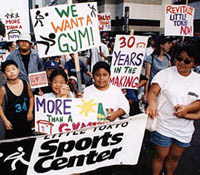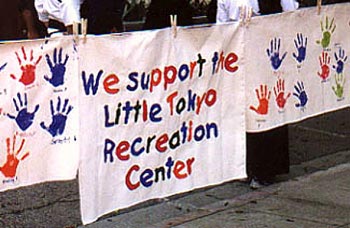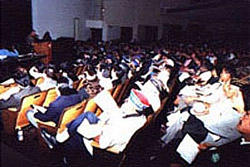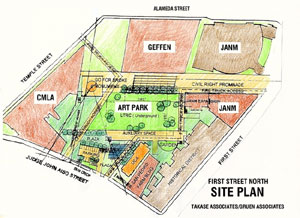 Home | Who We Are | Past Events | Open Forum | Campaign for Justice | Contact Info | Membership | Links | Search |
||||
 Home | Who We Are | Past Events | Open Forum | Campaign for Justice | Contact Info | Membership | Links | Search |
||||
|
First Street North Still Only
D
 espite the assurances of renowned architect Hayahiko Takase that the Little Tokyo Recreation Center could be built underground in such a way that it will not disrupt the planned Central Avenue Art Park or create additional noise for East West Players, elitist forces are conspiring to keep the Rec Center off the city-owned block north of First Street. espite the assurances of renowned architect Hayahiko Takase that the Little Tokyo Recreation Center could be built underground in such a way that it will not disrupt the planned Central Avenue Art Park or create additional noise for East West Players, elitist forces are conspiring to keep the Rec Center off the city-owned block north of First Street.Although Takase's plan for an underground Rec Center effectively addresses the concerns that the Japanese American National Museum, the Geffen Contemporary Museum, East-West Players and the Go For Broke Monument had raised previously about the proposed presence of the Rec Center on First Street North, the City of Los Angeles still has not granted the Rec Center a lease because JANM and the Geffen have expressed their disapproval of the project to LA City District Nine Councilwoman Jan Perry. At the heart of the Rec Center controversy is a conflict between two very different visions for Little Tokyo. One vision expresses a goal of status--Little Tokyo as a tourist destination with elite museums as the centerpiece. In this vision, the presence of actual Japanese Americans is largely unnecessary except to donate money and volunteer hours at JANM. In the vision supported by NCRR and many others, however, Little Tokyo is seen as a living community rather than as a commodity. As the cultural, historical and geographical home for Japanese Americans in the greater Los Angeles area as well as for many people of other ethnicities, Little Tokyo needs affordable housing, a recreation center and many other amenities to address the needs of the people who live, work and gather in Little Tokyo. Councilwoman Perry has encouraged the Little Tokyo Service Center to consider the former location of St. Vibiana's Cathedral on the block bordered by Second, Los Angeles and Main Streets. However, neither the city nor developer Tom Gilmore has been able to secure the land. Only one of the three parcels of land at the St. Vibiana's location has been purchased, and this single parcel is not big enough by itself to accommodate the Rec Center. Unless the other two parcels at the St. Vibiana's site can be secured, First Street North is the only viable location for the Rec Center. For updates on the Rec Center, visit http://reccenter.ltsc.org or call 213/473-1690.
Architect Unveils New Rec Center Plan PLAN CALLS FOR BUILDING GYMNASIUM UNDERGROUND AT FIRST STREET NORTH
Takase, whose projects include the Kajima Building, Higashi Hongwanji Temple and New Otani Hotel. said the new plans came out of a brainstorming session held July 17 with Takase, Bill Watanabe, Dean Matsubayashi of Little Tokyo Service Center and architect Michael Enomoto of Gruen Associates. Takase said it was an attempt to find a solution to the current impasse between proponents of the proposed rec center and Central Avenue Art Park projects. “One week after the July 10 (public) meeting. we had a brainstorm session and had a long discussion what to do. Michael Enomoto almost murmured. what if we buried our building, put it completely underground.” said Takase.
Michael Maltzan. the architect of the Art Park also made a presentation to the Community Council. Echoing earlier comments at the July 10 public hearing, he explained his concept for the park as an extension of Little Tokyo, with rows of cherry trees extending out of the park towards the trees recently planted on Central Ave. “What we were trying to do was imagine a way of creating a park that was both at the center of the block and in the sense was a frontyard for all the businesses and institutions.” said Maltzan. “We’ve looked at trying to imagine certain elements standing as an icon for the different participants around the park. So the cherry trees in a sense would really stand for Little Tokyo mov-ing into the park.” Following Maltzan’ s presentation, Takase said he was impressed by the Art Park proposal and supported both an Art Park and a rec center. “I really want to have an Art Park in this space,” said Takase. “But on the other hand, we need a rec center for kids. So it’s an architect’s duty to find a way to accommodate both an Art Park and gym together on the same block.” Takase said he worked “day and night for four days to come up with the plan and found inspiration from a simi-lar concept designed by Japanese archi-tect and Pritzker Architecture Prize win-ner Tadao Ando. First Street North stakeholder repre-sentatives, including George Takei, chairman of the Japanese American National Museum and Colonel Young, Oak Kim (ret.), chairman of the lOOth/ 442nd/MIS \VWII Memorial Founda-tion were in attendance at the meeting, along with Tom Kamei, president of the Japanese Chamber of Commerce, Brian Kito, president of the Little Tokyo Pub-lic Safety Association and Frances Hashirnoto. president of the Little To-kyo B usiness Association, and represen-tatives from Nikkei Student Union and Nikkei for Civil Rights and Redress. Speaking after the meeting, Takei said he was “intrigued” by Takase’s plan and praised the architects ingenuity. The JANM chair asked the architect ques-tions about sound proofing and passage-ways for local businesses to remove trash. Other concerns raised included where air conditioning units would be placed and the underground gym’s prox-imity to water pipes and the local water table. The architect said he believes that the technical issues can be worked out. “lts a great creative problem solv-ing attempt and I hope that it can be worked out. Obviously it’s in the very early stages. but the details can be cre-atively solved.’ said Takei. “With this conceptual plan comes a very high price tag. So that’s going to be another area that we all have to think about. But if this will get us past this unfortunate di-visiveness, and it all should have been avoidable ... I do applaud Mr. Takase for his creative problem solving.” Col. Kim expressed concerns that the Children’s Museum of Los Angeles would obstruct the Go For Broke Monu-ment. A representative from CMLA was not present at the meeting. “We’re going to fight anything that is going to he big and diminishes the value of the monument,’ said Kim to the Rafu Shimpo. ‘When the Children’s Museum idea came up. which was only about 3 or 4 years ago. we agreed to the concept of the Childrens Museum mov-ing into the Art Park. Two locations were mentioned. One was on Temple and Alameda and the other was Temple and Judge John Also. We voted for the Temple and John Aiso because we didn’t want it too close to the monument, over-shadowing it. Takase estimated that the under-ground plans could add an additional $2 to $2.5 million above the initial es-timates of $8.8 million. He also esti-mated that the structure would be 76,000 square feet and would have to be built at least 26 feet deep to accomodate the basketball courts. Takase emphasized that he felt that the additional expense would pale com-pared to the cost of land. “I think this is the last chance for the recreation center group to build a rec center. If we miss this chance, we will never build a rec center, forever. Because even if the city is nice enough to find another site, it takes time—2 to 3 years at least. In the meantime land prices are going up,” said Takase. August 17, 2002 Los Angeles Times LOS ANGELES Gym Proposal Takes Plans Underground Development: A compromise would put Little Tokyo facility 26 feet below ground and replace a parking lot with an art park. It also would increase the cost. |


